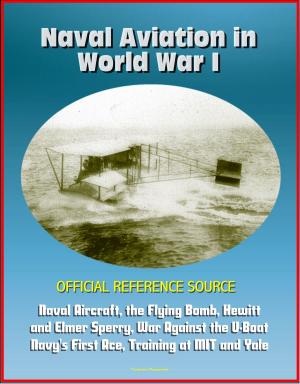Locating Air Force Base Sites: History's Legacy - Comprehensive Updated Reference on Air Force Basing History and Issues, Site Selection, BRAC Commissions, From the Army Air Corps to the War on Terror
Nonfiction, History, Military, Aviation| Author: | Progressive Management | ISBN: | 9781310087240 |
| Publisher: | Progressive Management | Publication: | September 16, 2014 |
| Imprint: | Smashwords Edition | Language: | English |
| Author: | Progressive Management |
| ISBN: | 9781310087240 |
| Publisher: | Progressive Management |
| Publication: | September 16, 2014 |
| Imprint: | Smashwords Edition |
| Language: | English |
This is a comprehensive history and analysis of the decisions about the siting of USAF bases. Historically, the ebb, flow, and utilization of Air Force installations are interconnected to changes in the size, composition, and capabilities of major flying and nonflying organizations. As a result, the number of USAF installations has fluctuated according to the complex interaction of the perceived global threat, technology, strategy, tactics, and projected force structure. This study describes military, technical, economic, and political reasoning that has influenced the location, or basing, of major flying and nonflying units in the continental United States, excluding Alaska, between 1907 and 2003. Specifically, it deals with the basing of bomber, fighter, airlift and missile units, training installations, logistic centers, and product centers. Locating flying and nonflying organizations involves assigning them to installations, usually Air Force bases, that are compatible with their missions. So closely related is the expansion, contraction, and relocation of USAF force structure to the utilization of base infrastructure that the two subjects must necessarily be considered together.
This volume is a groundbreaking effort intended as a reference work offering historical perspective on current basing issues. It examines four critical periods in the history of USAF basing. During the first period, from 1907 through August 1947, expansion of the Army's air force in response to two major wars established a foundation for the current basing network. The second period, September 1947 through 1960, saw a rapid expansion to support the rise of the United States Air Force as the major instrument of strategic deterrence. Radical retrenchment, followed by politically enforced stability, characterized the third period, 1961 to 1987. From 1961 through the mid-1970s, base infrastructure contracted steadily in response to changes in military threat, budgetary pressures, and the retirement of obsolete aircraft. From 1977 through 1987, strict interpretations of the National Environmental Policy Act effectively paralyzed basing actions, despite a moderate expansion of the force after 1980. During the fourth period, 1988-2003, the ending of the Cold War resulted in a substantial drawdown of force structure. The reality of sharply reduced forces, in combination with budgetary pressures, created a political consensus that permitted base closures and realignments to resume. Through 1987, the decision to open or close bases was, at least formally, strictly an executive branch prerogative. Beginning in 1988, the establishment of the Base Realignment and Closure (BRAC) Commission initiated the formal participation of Congress in basing decisions.
Chapter 1 - Locating Army Air Installations, 1907-1947 * A. Timothy Warnock * Trends and Factors Affecting Site Location * Pioneer Years, 1907-1917 * The Great War and Its Aftermath, 1917-1925 * The Army Air Corps Five-Year Plan, 1926-1935 * The Wilcox Act, 1935-1939 * World War II Expansion, 1940-1944 * Force Drawdown, 1944-1947 * Notes * Chapter 2 - Air Force Bases, 1947-1960 * Daniel L. Haulman * Force Expansion * The Base Selection Process * General Base Selection Criteria * Major Command Requirements * Strategic Forces Bases * Air Defense Bases * Tactical Forces Bases * Intertheater Airlift Bases * Flying Training Bases * Basic and Technical Training Bases * Education Bases * Air Materiel Bases * Research and Development Bases
This is a comprehensive history and analysis of the decisions about the siting of USAF bases. Historically, the ebb, flow, and utilization of Air Force installations are interconnected to changes in the size, composition, and capabilities of major flying and nonflying organizations. As a result, the number of USAF installations has fluctuated according to the complex interaction of the perceived global threat, technology, strategy, tactics, and projected force structure. This study describes military, technical, economic, and political reasoning that has influenced the location, or basing, of major flying and nonflying units in the continental United States, excluding Alaska, between 1907 and 2003. Specifically, it deals with the basing of bomber, fighter, airlift and missile units, training installations, logistic centers, and product centers. Locating flying and nonflying organizations involves assigning them to installations, usually Air Force bases, that are compatible with their missions. So closely related is the expansion, contraction, and relocation of USAF force structure to the utilization of base infrastructure that the two subjects must necessarily be considered together.
This volume is a groundbreaking effort intended as a reference work offering historical perspective on current basing issues. It examines four critical periods in the history of USAF basing. During the first period, from 1907 through August 1947, expansion of the Army's air force in response to two major wars established a foundation for the current basing network. The second period, September 1947 through 1960, saw a rapid expansion to support the rise of the United States Air Force as the major instrument of strategic deterrence. Radical retrenchment, followed by politically enforced stability, characterized the third period, 1961 to 1987. From 1961 through the mid-1970s, base infrastructure contracted steadily in response to changes in military threat, budgetary pressures, and the retirement of obsolete aircraft. From 1977 through 1987, strict interpretations of the National Environmental Policy Act effectively paralyzed basing actions, despite a moderate expansion of the force after 1980. During the fourth period, 1988-2003, the ending of the Cold War resulted in a substantial drawdown of force structure. The reality of sharply reduced forces, in combination with budgetary pressures, created a political consensus that permitted base closures and realignments to resume. Through 1987, the decision to open or close bases was, at least formally, strictly an executive branch prerogative. Beginning in 1988, the establishment of the Base Realignment and Closure (BRAC) Commission initiated the formal participation of Congress in basing decisions.
Chapter 1 - Locating Army Air Installations, 1907-1947 * A. Timothy Warnock * Trends and Factors Affecting Site Location * Pioneer Years, 1907-1917 * The Great War and Its Aftermath, 1917-1925 * The Army Air Corps Five-Year Plan, 1926-1935 * The Wilcox Act, 1935-1939 * World War II Expansion, 1940-1944 * Force Drawdown, 1944-1947 * Notes * Chapter 2 - Air Force Bases, 1947-1960 * Daniel L. Haulman * Force Expansion * The Base Selection Process * General Base Selection Criteria * Major Command Requirements * Strategic Forces Bases * Air Defense Bases * Tactical Forces Bases * Intertheater Airlift Bases * Flying Training Bases * Basic and Technical Training Bases * Education Bases * Air Materiel Bases * Research and Development Bases















